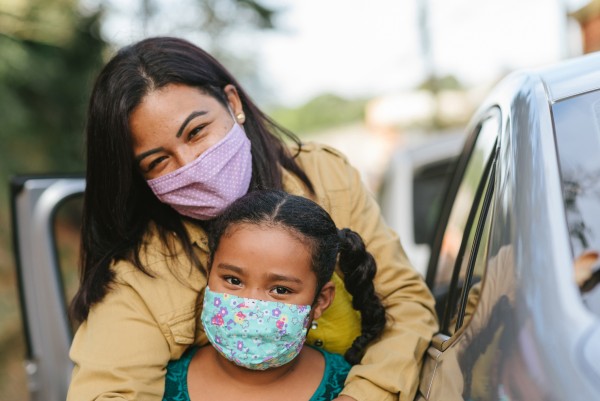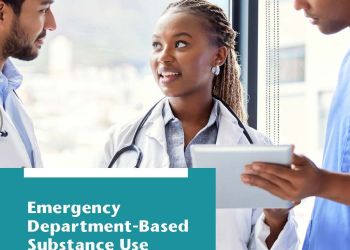Updated: 03/08/2021
COVID-19 has significantly impacted the maternal, child, and adolescent health (MCAH) population in many ways, including how children learn and play, and how birthing people experience the pregnancy and postpartum periods. Local health departments (LHDs) play a unique role in mitigating the impact of COVID-19 on MCAH populations. According to NACCHO’s 2019 National Profile of Local Health Departments, most LHDs provide Women, Infants, and Children (WIC) services (68%) to support the health of mothers and children. About a third of LHDs provide other direct clinical services to mothers and children, such as early and periodic screening, diagnosis, and treatment (EPSDT) (38%), prenatal care (30%), and well child clinics (30%). Given LHDs’ frequent interaction with families and individuals seeking preconception, prenatal, and postpartum care, as well as strong relationships with community partners, they must be equipped with accurate and timely date, resources, and information as it pertains to COVID-19. Thus, NACCHO’s Maternal Child and Adolescent Health team has rounded up noteworthy articles and release of new guidance related to COVID-19 relevant to the MCAH population.
New & Noteworthy
COVID-19, Pregnancy, and Postpartum Data
- Drawing on data from its repository of private healthcare claims, FAIR Health analyzed U.S. trends in maternal health before and during the pandemic. A few highlights from their findings are listed below:
- Deliveries from OB/GYNs increased by 14.7% from January to September 2020.
- From April 2019 to April 2020, deliveries in birthing centers increased by 172.22%—affirming the birthing in hospital concern.
- Gestational diabetes that occurs during pregnancy increased by 24.09% from January to September.
- Diagnoses of neonatal withdrawal syndrome, or neonatal abstinence syndrome—a group of problems that occur in newborns exposed to opioids in the uterus—increased 17.82% in the single month from April to May 2020. An increase in substance use has been documented nationally during the pandemic.
- Read more about their findings of the impact of COVID-19 on maternal health in this article.
- A retrospective cohort study examined of maternity practices (i.e. skin-to-skin care, rooming-in, and direct breastfeeding) increase the risk of clinically significant COVID-19 in newborns, and if disruption of these practices adversely affects breastfeeding. The study concludes that disruption of evidence-based quality standards of maternity care is associated with harm and may be unnecessary.
Study responses came from 31 countries. See the findings below:
- Among COVID-19 + mothers whose infection was ≤3 days after giving birth, 7.4% of their infants tested positive.
- There is no significant decrease in the risk of hospitalization among neonates who roomed-in, directly breastfed, or experienced uninterrupted skin-to-skin care.
- Infants who did not directly breastfeed, experience skin-to-skin care, or who did not room-in within arms’ reach, were significantly less likely to be exclusively breastfed in the first 3 months.
- Nearly 60% of mothers who experienced separation reported feeling “very distressed,” and 29% who tried to breastfeed were unable.
Vaccination Considerations for People Who are Pregnant
- Maternal Immunization Task Force and partners are urging that COVID-19 vaccines be available to pregnant individuals. The Task Force, comprised of ACOG, American Academy of Family Physicians, Association of Women’s Health, Obstetric and Neonatal Nurses and American College of Nurse-Midwives have released a statement along with numerous partners strongly recommending that pregnant individuals be allowed to receive the COVID-19 vaccine. According to their statement, there have been reports of pregnant individuals being refused vaccination. Their statement explains that, “currently, available data demonstrate that pregnant individuals are at increased risk of more severe illness and death due to COVID-19 than their non-pregnant counterparts. Providing pregnant individuals with the opportunity to be vaccinated can be critical to allowing them to protect themselves, particularly if their occupation puts them at increased risk of contracting the virus or they have underlying and comorbid conditions.” Read the full statement here.
Monitoring COVID-19 Vaccine Safety during Pregnancy
Currently, there is no evidence that COVID-19 vaccination causes any problems with pregnancy, including the development of the placenta. However, data are limited about the safety of COVID-19 vaccines for people who are pregnant. Because of this, the Centers for Disease Control and Prevention (CDC) and the Food and Drug Administration (FDA) have safety monitoring systems in place to capture information about vaccination during pregnancy and will closely monitor that information.
- CDC and FDA: Vaccine Adverse Event Reporting System (VAERS) external icon
- The national system to which healthcare professionals, vaccine manufacturers, and the public can report possible side effects or health problems that happen after vaccination. There is a question on the reporting form to identify pregnant people. Scientists used this information to investigate reports of events that are unexpected, appear to happen more often than expected, or have unusual patterns.
- CDC: v-safe
COVID-19 Vaccine Pregnancy Registry
- A registry to collect additional health information from v-safe participants who report being pregnant at the time of vaccination or a positive pregnancy test after vaccination. This information helps CDC monitor the safety of COVID-19 vaccines in people who are pregnant. V-safe is a new smartphone-based, after-vaccination health checker for people who receive COVID-19 vaccines.
- CDC: Vaccine Safety Datalink (VSD)
- A network of nine integrated healthcare organizations across the United States that monitor and evaluate the safety of vaccines. Through VSD, CDC will study:
- Weekly counts and rates of COVID-19 vaccination in pregnant people
- Miscarriage and stillbirth that occurs among people who received COVID-19 vaccine during pregnancy
- Adverse outcomes in pregnancy following COVID-19 vaccination, including pregnancy complications, birth outcomes, and infant outcomes for the first year of life
- A network of nine integrated healthcare organizations across the United States that monitor and evaluate the safety of vaccines. Through VSD, CDC will study:
- CDC: Clinical Immunization Safety Assessment (CISA) Project
- A collaboration between CDC and seven medical research centers to provide expert consultation on individual cases of adverse events after vaccination and conduct clinical research studies about vaccine safety. CISA will implement a clinical research study on COVID-19 vaccine safety among pregnant people at three sites.
- CDC: Birth Defects Study to Evaluate Pregnancy Exposures (BD-STEPS)
- This ongoing study collects information, including COVID-19 vaccination information, from people who have recently been pregnant to understand the potential causes of birth defects and how to prevent them.
COVID-19 and Children
- Newly Released: On March 12th the CDC released the Guidance for Operating Child Care Programs during COVID-19. This guidance is intended for all types of child care programs, including child care centers, family child care homes, Head Start programs, and other pre-kindergarten programs. This guidance outlines strategies that child care programs can use to maintain healthy environments and operations, lower the risk of COVID-19 spread in their programs, prepare for when someone if sick with COVID-19, and support coping and resilience.
- Newly Released: K-12 School Operational Strategy
- On February 12th the CDC released the K-12 School Operational Strategy. This document is intended to complement CDC’s guidance, tools, and resources for K-12 schools, including guidance on operating schools during COVID-19 and overview of testing for SARS-CoV-2 (COVID-19). This document also intends to complement the U.S. Department of Education’s Handbook on Strategies for Safely Reopening Elementary and Secondary Schools . It reflects evidence on COVID-19 among children and adolescents and what is known about SARS-CoV-2 transmission in schools, summarized in CDC’s Science Brief on Transmission of SARS-CoV-2 in K-12 Schools.
- CDC released an MMWR examining the effects of the COVID-19 pandemic on blood lead level testing rates. A copy of the publication titled “Decreases in young children who received blood lead level testing during COVID-19—34 Jurisdictions, January–May 2020” can be found here.
- Testing for elevated blood lead levels in children decreased 34% in January-May 2020, and by more than 50% during March-May 2020, when compared to the same period in 2019. The sharpest decrease (66%) occurred in April 2020, after the declaration of the COVID-19 national emergency in March 2020. With millions of children at risk for elevated blood lead levels, children who missed their screenings should be tested promptly to help prevent health problems and learning difficulties from toxic metal exposure. CDC’s Childhood Lead Poisoning Prevention Program works to reduce the number of children with elevated blood lead levels (BLLs) and eliminate BLL disparities and advance health equity in the United States.
- New York Times: COVID-linked Syndrome in Children is Growing, and Cases are more Severe. Doctors across the country have been seeing a striking increase in the number of young people with Multisystem Inflammatory Syndrome in Children, or MIS-C. This syndrome usually emerges several weeks after infection by COVID-19 and is still rare but very dangerous. Symptoms of the syndrome can include fever, rash, red eyes, or gastrointestinal problems, and these symptoms have the potential to progress into heart dysfunction. The reasons are still unclear, and doctors are uncertain which factors predispose children to the syndrome. Although the syndrome remains rare, the rate of cases has been increasing since October 2020. According to CDC data, since December 2020 there have been 2,060 cases in 48 states, Puerto Rico, and the District of Columbia, including 30 states.
- Clusters of SARS-CoV-2 Infection Among Elementary School Educators and Students in One School District
- Educators might play a central role in in-school transmission networks. Preventing SARS-CoV-2 infections through multifaceted school mitigation measures and COVID-19 vaccination of educators is a critical component of preventing in-school transmission.
- Joint Statement for COVID-19 Recovery Priorities to Meet Children’s Nutritional Needs (2/8/21)
- The Child Nutrition Forum/National Alliance for Nutrition and Activity (NANA) released their joint sign-on statement for COVID-19 recovery priorities. The joint statement was developed by the Food Research and Action Center, the Center for Science in Public Interest, and the American Health Association. FRAC facilitates the Child Nutrition Forum that urges Congress to make critical investments and improvements in Child Nutrition programs through the reauthorization process. This joint statement details recommendations to improve Pandemic EBT and Child Nutrition Waivers to support children’s nutrition during the pandemic.
Resources for Pregnant People and Parents
ACOG Resources
- ACOG Practice Advisory: Vaccinating Pregnant and Lactating Patients Against COVID-19
- COVID-19 Vaccines and Pregnancy: Conversation Guide for Clinicians
- ACOG and SMFM Joint Statement on WHO Recommendations Regarding COVID-19 Vaccines and Pregnant Individuals
- Vaccinating Pregnant Individuals: Eight Key Recommendations for COVID-19 Vaccination Sites
- Maternal Immunization Task Force and Partners Urge that COVID-19 Vaccine Be Available to Pregnant Individuals
- Coronavirus (COVID-19), Pregnancy and Breastfeeding: A Message for Patients
National WIC Association
CDC Resources
- Toolkit for Pregnant People and New Parents (cdc.gov)
- Pregnancy, Breastfeeding, and Caring for Newborns
- COVID-19 Vaccination Considerations for People Who Are Pregnant
- V-safe After Vaccination Health Checker
- People Who Need to Take Extra Precautions
- People with Certain Medical Conditions
- COVID-19 in Racial and Ethnic Minority Groups
- Communication Toolkit for Migrants, Refugees, and Other Limited-English-Proficient Populations
- Cleaning and Disinfection for Households
Print Resources



